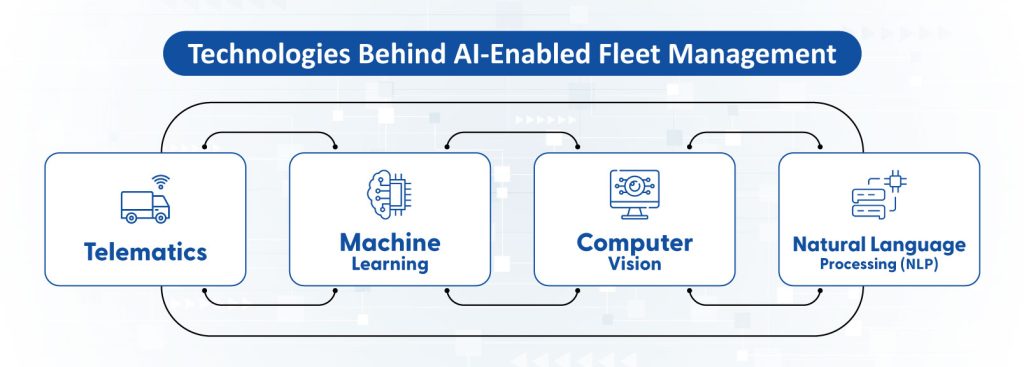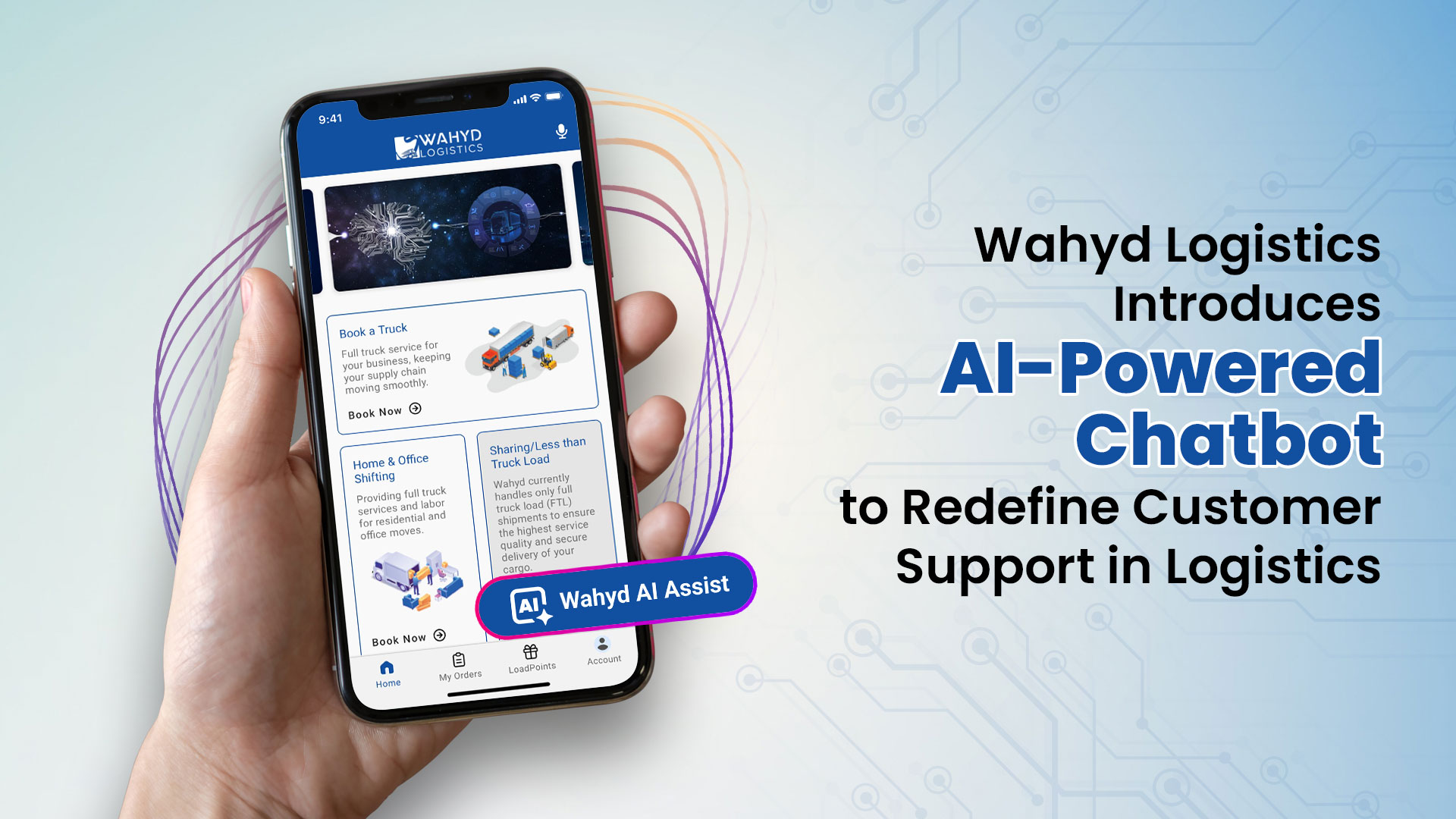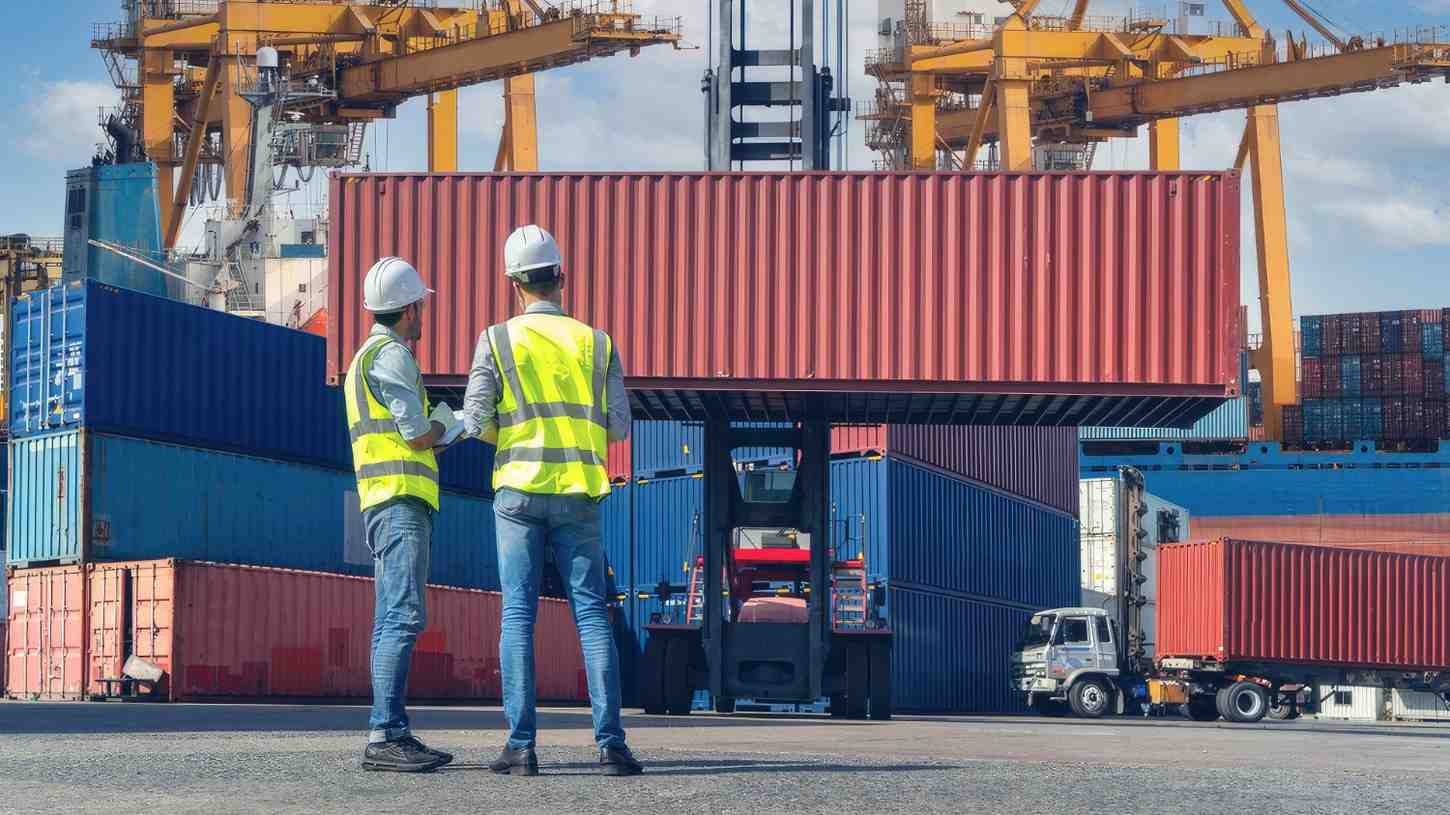
In logistics and transportation, the ‘Fleet Management’ concept has gone through a big change thanks to Artificial Intelligence (AI). Nowadays, AI is leading the way in improving fleet management by bringing a lot of efficiency and safety to the trucking business. This mix of AI and fleet management isn’t just a fancy tech upgrade, it’s changing the very way we do things, making fleet operations smoother, safer, and more efficient.
Moreover, the aspect of safety in trucking, a paramount concern for the industry has been significantly strengthened by AI. Advanced AI algorithms and machine learning models are now being employed to analyze driving patterns, predict potential hazards, and prevent accidents before they occur. This proactive approach to safety, powered by AI, is instrumental in protecting lives, reducing costs associated with accidents, and ensuring compliance with regulatory standards.
As we dive deeper into the role of AI in fleet management, we uncover a landscape where technology not only drives efficiency but also champions the cause of safety. In this blog, we aim to explore the multifaceted impact of AI in revolutionizing fleet management, offering insights into how this technology is setting new standards in efficiency and safety in trucking.
What is Fleet Management?
Fleet management is all about keeping a company’s bunch of vehicles in check. It’s super important for businesses where getting stuff from A to B is a big deal. The main goal? To keep costs down, make things run smoother, and avoid any risks that come with having a lot of vehicles on the road. This organized approach brings a lot of perks, like making sure vehicles are bought wisely, fuel is used efficiently, everything’s above board legally, keeping drivers safe, and even helping the environment by cutting down on emissions.
At the heart of it all are the fleet managers. They’ve got a lot on their plate, like making sure vehicles are in the best of shape, keeping an eye on fuel use and costs, managing drivers effectively, using vehicles in the best way possible, planning to outsmart routes, and putting in place strategies to make the whole company more efficient and less wasteful.
To make all this happen, organizations often turn to cool tools and tech, like vehicle telematics and fleet management software. These high-tech helpers make managing a fleet way easier, streamline day-to-day operations, and help cut down on costs.
The evolution of logistics is deeply connected to the transformation of fleet management. As logistics advanced from basic transportation and storage to complex supply chain orchestration, fleet management simultaneously evolved, integrating cutting-edge technologies like GPS tracking, AI, and IoT to enhance efficiency, safety, and real-time decision-making.
What are the Technologies Behind AI-Enabled Fleet Management?
AI is at the forefront of reshaping fleet management, working side by side with other technologies like the Internet of Things (IoT) and big data analytics. This section sheds light on the pivotal role played by these technologies in enhancing operational efficiency, predictive maintenance, and data-driven decision-making.

Telematics
Telematic systems play a crucial role in modern fleet management by collecting and analyzing real-time data from various vehicle sensors. This technology gathers information such as location through GPS, speed via accelerometers, and vehicle health using engine sensors. The wealth of data can be overwhelming for fleet managers, which is where AI steps in to process and translate this data into actionable insights.
By leveraging AI algorithms, telematics systems can turn large data sets into meaningful insights about vehicle performance and driver behavior. These insights can help fleet managers identify potential issues and take proactive measures to enhance fleet efficiency and productivity. Which results in a significant reduction in fleet accidents a primary advantage of integrating AI into telematics systems.
Machine Learning
Machine learning is like giving your computer a brain that learns on its own. When you feed it telematics data, which is just fancy talk for all the info from your vehicles (like where they go, how fast they drive, etc.), the computer starts to pick up patterns without anyone having to tell it what to do. It’s like teaching it to understand and predict stuff by itself.
This is super handy for businesses. Imagine being able to guess what’s going to happen before it does. That’s what machine learning can do. For example, by looking at all the past data from your vehicles, you can predict when they might need a check-up or repair. This is way better than waiting for something to break down, right? It keeps everyone safer and saves money because you’re fixing things before they become big, expensive problems.
When you mix AI and machine learning with telematics, it’s like putting your fleet management on steroids. you get way more efficient, keeping things safe, and don’t spend as much money. And it’s not just for managing vehicles; lots of other areas can use this smart, data-driven approach too.
Computer Vision
Nowadays, in the world of managing a bunch of cars and trucks (that’s fleet management for you), there are some cool gadgets and tech that help keep things safe on the road. Think of stuff like lane departure warnings and blind spot detection- they’re like extra eyes and ears for drivers.
These systems use high-tech gear like sensors, cameras, and something called LIDR (which is a bit like radar but with light) to help drivers avoid accidents. For example, a lane departure warning is like a friendly nudge that says, “Hey, you’re drifting out of your lane!” It’s super helpful for stopping those little drifts we all do sometimes without realizing it.
Blind spot detection is another lifesaver. It spots cars hanging out in those tricky areas you can’t see in your mirrors and gives you a heads-up. And then there’s video telematics- it’s like having a bunch of cameras and data working together to keep an eye on how the road looks, how alert the driver is, and what’s happening around the vehicle. It’s all about making sure everyone stays safe and cutting down on risks.
In short, these gadgets are changing the game of keeping roads safe and making sure everything runs smoothly and efficiently.
Natural Language Processing (NLP)
NLP, or Natural Language Processing, is like giving AI the superpower to understand and use human language. It’s really handy in making conversations between drivers and fleet managers a breeze. Think of it as a helpful assistant in the vehicle. Drivers can just speak to it- asking it to make phone calls, check out the latest traffic updates, or find a quicker way to get somewhere. This makes things a lot smoother and more efficient.
But it’s not just about making life easier for drivers. Fleet managers can use NLP too. They can send quick voice messages to drivers. So, if a driver is, say, speeding a bit or not driving safely, the manager can give them a heads-up right away. This instant chat helps keep everyone on their toes and makes driving safer.
The coolest part? This AI and NLP stuff lets drivers keep their hands on the wheel and eyes on the road while they talk to their vehicle. Less fiddling with gadgets means fewer distractions and a smaller chance of accidents.
The real-world effectiveness of NLP would depend on various factors, including technological integration, system design, and user experience.
AI and Fleet Management: A Synergistic Relationship
The fusion of AI with fleet management is not just an advancement; it’s a revolution. AI’s capability to process and analyze large datasets from various sources like vehicle sensors, GPS systems, and traffic data, provides unprecedented insights for fleet managers. Let’s explore how AI is optimizing operational efficiency and bolstering safety in the trucking industry.
Improving Operational Efficiency
Predictive Maintenance
AI-driven predictive maintenance is changing the way we manage vehicle fleets by making maintenance schedules smarter. Using special sensors and data analysis, these AI systems keep an eye on important things like how the engine is doing, the condition of the tires, and the levels of various fluids, all in real time. What’s cool is that by looking at past data and spotting trends, AI can figure out possible maintenance issues before they turn into big problems.
This means companies can plan maintenance and repairs when it’s most convenient, reducing the time vehicles are out of service and making the fleet more available. This forward-thinking approach not only makes operations smoother but also helps vehicles last longer, cutting down on overall maintenance costs.
Fuel Management
Fuel management looms as a pivotal component of cost optimization and sustainability. The financial implications of fuel expenses are profound, making it imperative for businesses to manage fuel consumption actively. Fleet managers can meticulously gauge and analyze fuel usage by deploying fuel tracking systems.
This data serves as a treasure trove, enabling managers to pinpoint areas for enhancement and execute strategies aimed at curtailing fuel consumption. An illustrative example is the role of a fleet tracker, which, by offering insights into fuel efficiency, empowers managers to make data-informed decisions that optimize routes and reduce delivery time.
Route Optimization
AI-powered route planning is revolutionizing the way truck routes are planned by taking into account real-time traffic, weather, and other factors. These smart systems use both past and present data to figure out the best paths, helping to cut down on travel time and save fuel.
They’re adaptable, giving drivers up-to-the-minute updates and different ways to go to steer clear of traffic jams or closed roads. This smart way of planning routes not only makes things run more smoothly but also keeps customers happy by making sure deliveries arrive on time.
Streamlining Supply Chain and Logistics
AI technology is making the supply chain and logistics in the trucking industry much smoother. AI systems can sift through huge amounts of information about things like how much stuff is in stock, what customers need, and the best ways for trucks to get places. By fine-tuning these details, AI finds the smartest routes, cuts down on trips without cargo, and helps plan better for carrying loads.
Also, AI helps predict what customers will want and manages stock levels well, helping companies keep their inventory costs low. With a clearer view of the supply chain and better efficiency, trucking companies can offer better customer service, lower their costs, and stay ahead in the market.
Improved Customer Service
An AI-powered solution provides fleet operators with a holistic view of operations to better meet customer needs. Accurate ETAs, proactive notifications about potential delays, and seamless delivery tracking are made possible through AI. This results in higher customer satisfaction and loyalty.
The fleet management industry will likely continue to adopt AI and machine learning to remain competitive, reduce costs, and meet sustainability targets. Though developing an AI system requires time and resources, the long-term benefits to fleet performance, profitability, and environmental impact make AI a worthwhile investment. By harnessing the power of artificial intelligence and big data, fleet operators can achieve significant operational efficiencies and a strategic advantage.
Automated Paperwork and Compliance
AI can automate much of the paperwork involved in trucking logistics, from freight billing to regulatory compliance. This reduces administrative overhead and minimizes the risk of human error, leading to more efficient operations.
Data-Driven Decision Making
AI tools process large amounts of data to provide insights and trends in fleet operations. This helps in making informed, data-driven decisions that can lead to operational improvements and cost savings.
Enhancing Safety in Trucking
Driver Assistance and Safety Features
AI-powered driver assistance features are improving safety in the trucking industry. These features include collision avoidance systems, adaptive cruise control, and lane departure warnings. By utilizing sensors and AI algorithms, these systems can detect potential hazards, provide alerts, or take corrective actions.
For example, collision avoidance systems can automatically apply brakes in emergencies, reducing the risk of rear-end collisions. Adaptive cruise control adjusts the vehicle’s speed to maintain a safe distance from other vehicles. Lane departure warnings alert drivers when they unintentionally drift out of their lane. Driver assistance features enhance safety by assisting drivers in avoiding potential accidents.
AI-Enabled Video Analytics for Accident Prevention
AI-enabled video analytics systems review video from cameras in trucks to spot dangerous driving habits like driving too close to other vehicles, making risky moves, or not paying attention while driving. These AI tools can help in teaching drivers better habits by pointing out these risky behaviors.
They’re also useful in figuring out what happened in accidents, offering clear data and visual proof. By catching these high-risk actions early, AI video analytics plays a big role in preventing accidents. They encourage safer driving and help make the roads safer for everyone.
Real-Time Monitoring and Early Warning Systems
AI technologies are at the heart of real-time monitoring and early warning systems that help spot and lessen dangers on the road. These systems use high-tech sensors and AI to keep an eye on how the driver is acting, how the vehicle is running, and what’s happening around them. By looking at data as it comes in, they can notice if a driver is getting tired, not paying attention, or driving oddly.
These systems quickly alert both the driver and the people managing the fleet, allowing for fast action to prevent accidents. Real-time monitoring and early warning systems boost safety by actively dealing with potential issues and encouraging drivers to stay safe on the road.
Fatigue and Distraction Monitoring
Fatigue and distractions pose significant risks to truck drivers. AI-based fatigue and distraction monitoring systems utilize advanced technologies such as facial recognition and eye tracking to detect signs of fatigue or distraction in real-time. These systems alert drivers, reminding them to take breaks or refocus their attention, thus preventing accidents caused by driver fatigue or distractions.
Training and Skill Development
AI-powered training and skill improvement programs are helping truck drivers get better at their jobs and keep up with the latest trends in the industry. Through virtual reality (VR) setups, online courses, and personalized learning platforms that use AI, drivers can get training that fits their needs, practice in tricky situations, and sharpen their skills. These kinds of programs are great for professional development, making drivers feel more satisfied with their jobs, and boosting their confidence.
Conclusion
AI technology is transforming fleet management in big ways, making trucking logistics smarter, safer, and more cost-effective. With the help of cutting-edge tech like telematics, machine learning, and AI-powered video analysis, managing fleets has moved from old-school methods to a more proactive and efficient approach. Bringing AI into fleet management not only makes daily operations smoother but also greatly improves safety on the road. This makes the trucking world more dependable and long-lasting.
As AI keeps growing and changing, its role in fleet management is set to create new benchmarks in how well operations run, in keeping everyone safe, and in making customers happy. This points to a future where the trucking industry is more connected, smarter, and able to bounce back from challenges.
Discover how Wahyd Logistics is changing the future of trucking and logistics in the GCC, South Asia, and Central Asia.
Visit our website to learn more and read our insightful blogs for actionable industry insights.






